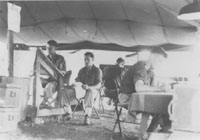


War History of the Australian Meteorological Service
Foreword
Preface
Introduction
Chapter 1: D.Met.S.—Australia's Wartime Weather Service
Chapter 2: The Weather Factor in Warfare
Chapter 3: Met in the Retreat
Chapter 4: Met in the Advance
Chapter 5: Meteorology in Aviation
Chapter 6: Central Forecasting Services
Chapter 7: Met With the Army
How Weather Formations Were Created as Essential to the Army
Establishments Throughout Australia
Meteorological Staff Officer
Disposition of Flights
Successive Movements to Pacific Theatres
The Close of Hostilities
Chapter 8: Research and Personnel Training
Chapter 9: Instrumental Development and Maintenance
Chapter 10: Scientific Developments in the RAAF Meteorological Service
Chapter 11: Divisional Bureaux and Their Work
Appendix 1: List of Reports Provided by D.Met.S. for Advances Operational Planning and Other Purposes
Appendix 2: List of Service Personnel RAAF Meteorological Service
Appendix 3: List of Civilian Personnel Who Worked Together with Service Personnel of the RAAF Meteorological Service
Appendix 4: List of Locations at which RAAF Meteorological Service Personnel Served
Index
Search
Help
Contact us

Successive Movements to Pacific Theatres (continued)
During February 1945 Fl Lts F. Bell and J. H. Lord, together with FO A. T. Brunt, met at the headquarters of the First Army in Melbourne to discuss the organisation and disposition of Nos 3, 5 and 6 Flights in the 1st Army area, while Fl Lt G. R. Trefry arrived late in the month from 1 Australian Corps for conferences concerning the remaining three flights.In March 1945 a detachment from No 3 Flight was in action with the 2/2 Australian Field Regiment at Matapau, where it performed what was considered to be an outstanding achievement in providing a meteor correction of 1025 yards for a battery firing super charge from the Anumb River to the outer defences of But, with our own troops disposed less than 300 yards from the target area. This shooting was described as completely accurate and contributed substantially to the fall of But. Detachments in this area functioned under extremely difficult conditions, including long trips for water in order to produce hydrogen for pilot balloons. Similar circumstances were encountered at the time by detachments of No 5 Flight operating at Puto (Genga River).
No 1 Flight returned to the area of the battle in April 1945, leaving Townsville by American transport and reaching Morotai in preparation for the Borneo offensive in mid-month. A detachment from No 2 Flight also arrived at Morotai at this time subsequently going into action at Tarakan (Borneo) but flight headquarters did not reach the island until 1 May, thereupon moving to 9 Division headquarters at Sabetai River, North-West Borneo. No 3 Flight headquarters by this time had transferred with headquarters, RAA, to But in New Guinea, with No 5 Flight still operating at Torokina in the Solomons, with detachments at Soraken Plantation and in the Laruma Valley.
At Tarakan preparation of meteors by the detachment of No 2 Flight was accomplished with difficulty. Night pilot balloon flights were subject to undivided attention of enemy snipers. On more than one occasion the detachment jeep narrowly escaped damage from mines. Extra care was taken after a vehicle preceding the weather jeep struck a mine and was destroyed with all its occupants.
Early in May a detachment of No 3 Flight moved from Karawop to Cape Wom, approximately three miles north-west of Wewak in New Guinea, and a week later flight headquarters moved up by barge. Before the end of the month, also, another detachment of this flight became established at Cape Boram.

People in Bright Sparcs - Bell, Fred; Brunt, Allan Thomas
 |
Bureau of Meteorology |  |
© Online Edition Australian Science and Technology Heritage Centre and Bureau of Meteorology 2001
Published by Australian Science and Technology Heritage Centre, using the Web Academic Resource Publisher
http://www.austehc.unimelb.edu.au/fam/0691.html